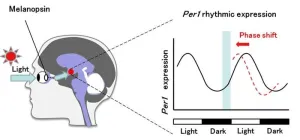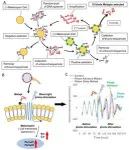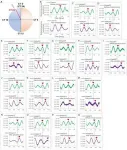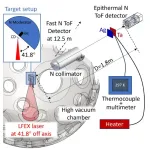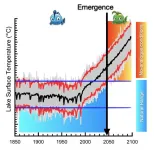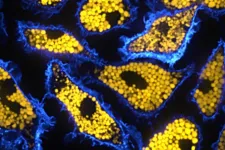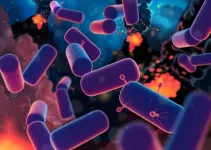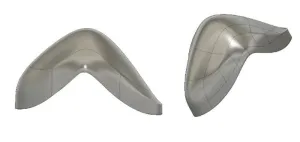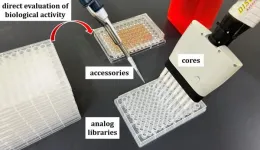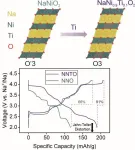(Press-News.org) Overview:
DNA aptamers of melanopsin that regulate the clock hands of biological rhythms were developed by the Toyohashi University of Technology and the National Institute of Advanced Industrial Science and Technology (AIST) group.
DNA aptamers can specifically bind to biomolecules to modify their function, potentially making them ideal oligonucleotide therapeutics. We screened the DNA aptamer melanopsin (OPN4), a blue light photopigment in the retina that plays a key role in the use of light signals to reset the phase of circadian rhythms in the central clock.
First, 15 DNA aptamers of melanopsin (Melapts) were identified following eight rounds of Cell-SELEX using cells expressing melanopsin on the cell membrane. Subsequent functional analysis of each Melapt was performed in a fibroblast cell line stably expressing both Period2:ELuc and melanopsin by determining the degree to which they reset the phase of mammalian circadian rhythms in response to blue light stimulation. Period2 rhythmic expression over a 24-h period was monitored in Period2:ELuc: thymidine kinase (TK):OPN4 stable fibroblasts expressing melanopsin. At subjective dawn, four Melapts were observed to advance their phase by >1.5 h, whereas seven Melapts delayed their phase by >2 h. A few Melapts caused a phase shift of approximately 2 h, even in the absence of photostimulation, presumably because Melapts can only partially affect input signaling for the phase shift. Additionally, a few Melaps-induced phase shifts in Period1::luc transgenic (Tg) mice were used to monitor circadian rhythms by Period1 rhythmic expression.
These DNA aptamers may have the capacity to affect melanopsin in vivo. In summary, Melapts aptamers can successfully regulate the input signal and the shifting phase (both phase advance and phase delay) of mammalian circadian rhythms in vitro and in vivo.
Details:
Indirectly improving the sleep–wake cycle by manipulating the ability of melanopsin to input signals to the central clock would be socially and economically advantageous.
Melanopsin is a photoreceptor protein expressed in retinal ganglion cells that absorbs blue light with a maximum absorbance of 477 nm. Melanopsin is known to play an important role in resetting the phase of the mammalian circadian clock by blue light and the rhythmic expression of clock genes, such as Period1,2 (Per1,2). The phase of the molecular circadian clock is reset by and depends on the timing of light stimulation and the transient induction of Per1 by the melanopsin photoreceptor (Fig. 1). Recently, antagonists of melanopsin acquired via chemical screening of chemical libraries primarily contribute to delaying the rhythm phase.
In this study, we used the cellular systematic evolution of ligands by the exponential enrichment (Cell-SELEX) method to identify DNA aptamers (single-stranded DNA; ssDNA) that cause melanopsin to shift the phase of circadian rhythms. In total, 15 types of melanopsin aptamers (Melapts 1–15) were analyzed to assess their ability to shift the phase of Per2::ELuc bioluminescent oscillations in Per2:ELuc:TK:Mel stable cells, in which a bioluminescent reporter follows the Per2 promoter region controlling an enhanced green-emitting luciferase from Pyrearinus termitilluminans, with melanopsin overexpressed under the control of the thymidine kinase (TK) promotor. In these stable fibroblast cell lines, the signaling pathway is incorporated into a fibroblast cell that mimics the signaling pathway from the retina to the central master clock (suprachiasmatic nucleus or nuclei: SCN) by melanopsin (Fig. 2).
DNA aptamers are short, single-stranded RNA/DNA molecules that can bind selectively to specific targets, proteins, peptides, and other molecules and can be used clinically to switch the function of target molecules. The main advantages of these aptamers include their high target specificity, lack of immunogenicity, and ease of synthesis.
Among the 15 DNA aptamers of melanopsin (Melapts), four Melapts induced a phase advance and seven Melapts induced a delay in circadian rhythms (by >1.5 h and > 2 h, respectively) in the Per2::ELuc cell line. A few Melapts induced phase shifts of approximately 2 h, even in the absence of photostimulation in vitro.
Melapt04 and Melapt10 induced a phase advance or delay of the circadian clock by approximately 3 h, respectively, at both CT22 and CT8 during the photo signal input process. This suggests that Melapt04 regulates the phase of circadian rhythms and facilitates falling asleep and waking, mainly via phase advance (Fig. 3–5). Two Melaptes exist that advance and delay the phase shift in the same direction, regardless of the timing of the photostimulus. However, the three Melaptes advanced and delayed the phase shift in opposite directions at dawn and dusk. Therefore, these Melapts are expected to be useful for regulating the phases of rhythms (Fig. 6,7).
We performed in vivo experiments similar to the in vitro experiments to investigate whether Melapt binding to melanopsin in the retina projecting to the SCN affected the phase shifts of the central clock in the SCN. Per1::luc transgenic mice: mice in which the Per1::luc recombinant gene was inserted into the genome of all cells. Per1::luc is a recombinant gene in which the Per1 promoter region is followed by a luciferase enzyme derived from fireflies as a reporter to monitor circadian rhythms.
Eight types of Melapt-causing phase-shift responses in Per2 expression rhythms in the in vitro experiments were injected into the bulbs of the eyes of Per1::luc Tg mice at CT22 (Fig. 8, 9). Melapt01, Melapt03, Melapt04, Melapt07, Melapt09, and Melapt10 displayed phase-shift abilities similar to those of Per2:ELuc:TK:Mel stable cells: in vivo and in vitro.
The effect of Melapt on phase shift in in vivo experiments can be predicted from in vitro experiments. In addition, the total phase shifts were limited to 3 h in intact animals, regardless of the extent of advance or delay by Melapts in Per2:Eluk:TK:Mel cells.
In conclusion:
In summary, Melapts were able to regulate input signals and phase shifts to achieve both phase advance and phase delay in mammalian circadian rhythms in vitro and in vivo.
Melapts could contribute to future research focused on resetting circadian clock phases. Melapts could help us better adapt to modern social life cycles, allow crops and domestic animals to be improved for greater productivity, and help shift workers overcome social jet lag by adjusting the phases of the circadian clock. These Melapts could contribute to resetting the phase of the circadian clocks in photic input pathways.
Funding agency:
This study was supported by research funding from TechnoPro Inc., TechnoPro R&D Company, and the Program to Foster Young Researchers in Cutting-edge Interdisciplinary Research (RN). Funding for Kiban Scientists (to RN 24590350 and 20H00614) was obtained from the Japan Society for the Promotion of Science (JSPS), Mitsubishi Science Foundation (to RN), and a Research Grant for Science and Technology Innovation at Toyohashi University of Technology (to RN). This study was also supported by the Ministry of Education, Culture, Sports, Science, and Technology of Japan(YN 21H02083).
Reference:
“Melanopsin DNA aptamers can regulate input signals of mammalian circadian rhythms by altering the phase of the molecular clock”
Kazuo Nakazawa1,2, Minako Matsuo3,Yo Kikuchi,i1,3,Yoshihiro Nakajima4,Rika Numano1,3
1Department of Applied Chemistry and Life Science, Toyohashi University of Technology, Toyohashi, Aichi, Japan
2TechnoPro, Inc., Tokyo, Japan
3Institute for Research on Next-Generation Semiconductor and Sensing Science, Toyohashi University of Technology, Toyohashi, Aichi, Japan
4Health and Medical Research, National Institute of Advanced Industrial Science and Technology (AIST), Takamatsu, Kagawa, Japan
Frontiers in Neuroscience, Sec. Sleep and Circadian Rhythms, Volume 18, 2024
https://doi.org/10.3389/fnins.2024.1186677
END
Melanopsin DNA aptamers can regulate input signals of mammalian circadian rhythms by altering the phase of the molecular clock
DNA aptamers Melapts to wake up refreshed in the morning.
2024-07-12
ELSE PRESS RELEASES FROM THIS DATE:
Challenges and prospects for post-conflict peacebuilding in urban settings
2024-07-12
Wars and conflicts leave devastating destruction in their wake. With so many conflicts now taking place in urban environments, scientists are studying how post-conflict peacebuilding happens in these urban settings. Dahlia Simangan, an associate professor at The IDEC Institute, Hiroshima University, has analyzed the case of Marawi, a city in the Philippines, to better understand the urban environment’s influence on post-siege reconstruction and peacebuilding. This study contributes to a more comprehensive understanding of peacebuilding by integrating conventional peacebuilding components and urban characteristics.
The findings are published ...
Neutrons give a hot new way to measure the temperature of electronic components
2024-07-12
Osaka, Japan – From LEDs to batteries, our lives are full of electronics, and there is a constant push to make them more efficient and reliable. But as components become increasingly sophisticated, getting reliable temperature measurements of specific elements inside an object can be a challenge.
This is problematic because measuring a device’s temperature is vital for monitoring its performance or designing the materials from which it’s manufactured. Now, in a new study led by Osaka ...
High and low tide cause low and high methane fluxes
2024-07-12
High and low tide cause low and high methane fluxes
Methane, a strong greenhouse gas that naturally escapes from the bottom of the North Sea, is affected by the pressure of high or low tide. Methane emissions from the seafloor can be just easily three times as much or as little, depending on the tide. This is shown by NIOZ oceanographer Tim de Groot, in a publication in Nature Communications Earth and Environment. "Our research shows that you can never rely on one measurement when you want to know how much methane escapes from the seafloor," De Groot emphasizes.
Swamp ...
A better way to make RNA drugs
2024-07-12
While the COVID-19 vaccines introduced many people to RNA-based medicines, RNA oligonucleotides have already been on the market for years to treat diseases like Duchenne Muscular Dystrophy and amyloidosis. RNA therapies offer many advantages over traditional small molecule drugs, including their ability to address almost any genetic component within cells and to guide gene editing tools like CRISPR to their targets.
However, the promise of RNA is currently limited by the fact that rapidly growing global demand is outpacing the industry’s ability to manufacture it. The standard method of chemically ...
Unprecedented warming threatens earth’s lakes and their ecosystems
2024-07-12
Lakes, with their rich biodiversity and important ecological services, face a concerning trend: rapidly increasing temperatures. A recent study published in Nature Geoscience by an international team of limnologists and climate modelers reveals that if current anthropogenic warming continues until the end of this century, lakes worldwide will likely experience pervasive and unprecedented surface and subsurface warming, far outside the range of what they have encountered before.
The study uses lake temperature ...
Cellular inflammation uncovered in rare neurodegenerative condition
2024-07-12
Researchers at The Hospital for Sick Children (SickKids) have found that inflammation in an immune cell may be responsible in part for some severe symptoms in a group of rare genetic conditions called lysosomal storage diseases (LSDs).
LSDs affect about one in 7,700 live births worldwide. Children with the condition typically present at a young age with progressive neurodegeneration. Many children with LSDs die prematurely, and current treatments focus on symptom management.
Until now, the role of macrophages in the immune system and LSDs was ...
Insight into one of life’s earliest ancestors revealed in new study
2024-07-12
An international team of researchers led by the University of Bristol has shed light on Earth’s earliest ecosystem, showing that within a few hundred million years of planetary formation, life on Earth was already flourishing.
Everything alive today derives from a single common ancestor known affectionately as LUCA (Last Universal Common Ancestor).
LUCA is the hypothesized common ancestor from which all modern cellular life, from single celled organisms like bacteria to the gigantic redwood trees (as well as us humans) descend. LUCA represents the root ...
Real-life ‘stillsuit’: Dune-inspired upgrade for spacesuits allow astronauts to recycle urine into water
2024-07-12
Astronauts on spacewalks famously have to relieve themselves inside their spacesuits. Not only is this uncomfortable for the wearer and unhygienic, it is also wasteful, as – unlike wastewater on board the International Space Station (ISS) – the water in urine from spacewalks is not recycled.
A solution for these challenges would be full-body ‘stillsuits’ like those in the blockbuster Dune franchise, which absorbed and purified water lost through sweating and urination, and recycled it into drinkable water. Now, this sci-fi ...
A comprehensive derivative synthesis method for development of new antimicrobial drugs
2024-07-12
A method to screen a wide variety of drug candidates without laborious purification steps could advance the fight against drug-resistant bacteria.
Efforts to combat the increasing threat of drug-resistant bacteria are being assisted by a new approach for streamlining the search for antimicrobial drug candidates, pioneered by researchers at Hokkaido University, led by Assistant Professor Kazuki Yamamoto and Professor Satoshi Ichikawa of the Faculty of Pharmaceutical Sciences. Their methods, developed together with researchers elsewhere in Japan and in the USA, are discussed ...
Improving cycling performance of sodium-ion batteries through titanium substitution
2024-07-12
Researchers at Karlsruhe Institute of Technology (KIT) have made significant advances in sodium-ion battery (SIB) technology by improving cycling performance of the NaNiO2 cathode. They successfully synthesized, for the first time, the cathode active material NaNi0.9Ti0.1O2, which delivers a specific capacity of 190 mAh/g, thus positioning it as a potential candidate for application in high-energy-density SIBs. This innovative approach not only improves battery stability but also propels us toward advanced energy-storage solutions beyond.
With its high theoretical ...
LAST 30 PRESS RELEASES:
The vast majority of US rivers lack any protections from human activities, new research finds
Ultrasound-responsive in situ antigen "nanocatchers" open a new paradigm for personalized tumor immunotherapy
Environmental “superbugs” in our rivers and soils: new one health review warns of growing antimicrobial resistance crisis
Triple threat in greenhouse farming: how heavy metals, microplastics, and antibiotic resistance genes unite to challenge sustainable food production
Earthworms turn manure into a powerful tool against antibiotic resistance
AI turns water into an early warning network for hidden biological pollutants
Hidden hotspots on “green” plastics: biodegradable and conventional plastics shape very different antibiotic resistance risks in river microbiomes
Engineered biochar enzyme system clears toxic phenolic acids and restores pepper seed germination in continuous cropping soils
Retail therapy fail? Online shopping linked to stress, says study
How well-meaning allies can increase stress for marginalized people
Commercially viable biomanufacturing: designer yeast turns sugar into lucrative chemical 3-HP
Control valve discovered in gut’s plumbing system
George Mason University leads phase 2 clinical trial for pill to help maintain weight loss after GLP-1s
Hop to it: research from Shedd Aquarium tracks conch movement to set new conservation guidance
Weight loss drugs and bariatric surgery improve the body’s fat ‘balance:’ study
The Age of Fishes began with mass death
TB harnesses part of immune defense system to cause infection
Important new source of oxidation in the atmosphere found
A tug-of-war explains a decades-old question about how bacteria swim
Strengthened immune defense against cancer
Engineering the development of the pancreas
The Journal of Nuclear Medicine ahead-of-print tip sheet: Jan. 9, 2026
Mount Sinai researchers help create largest immune cell atlas of bone marrow in multiple myeloma patients
Why it is so hard to get started on an unpleasant task: Scientists identify a “motivation brake”
Body composition changes after bariatric surgery or treatment with GLP-1 receptor agonists
Targeted regulation of abortion providers laws and pregnancies conceived through fertility treatment
Press registration is now open for the 2026 ACMG Annual Clinical Genetics Meeting
Understanding sex-based differences and the role of bone morphogenetic protein signaling in Alzheimer’s disease
Breakthrough in thin-film electrolytes pushes solid oxide fuel cells forward
Clues from the past reveal the West Antarctic Ice Sheet’s vulnerability to warming
[Press-News.org] Melanopsin DNA aptamers can regulate input signals of mammalian circadian rhythms by altering the phase of the molecular clockDNA aptamers Melapts to wake up refreshed in the morning.
